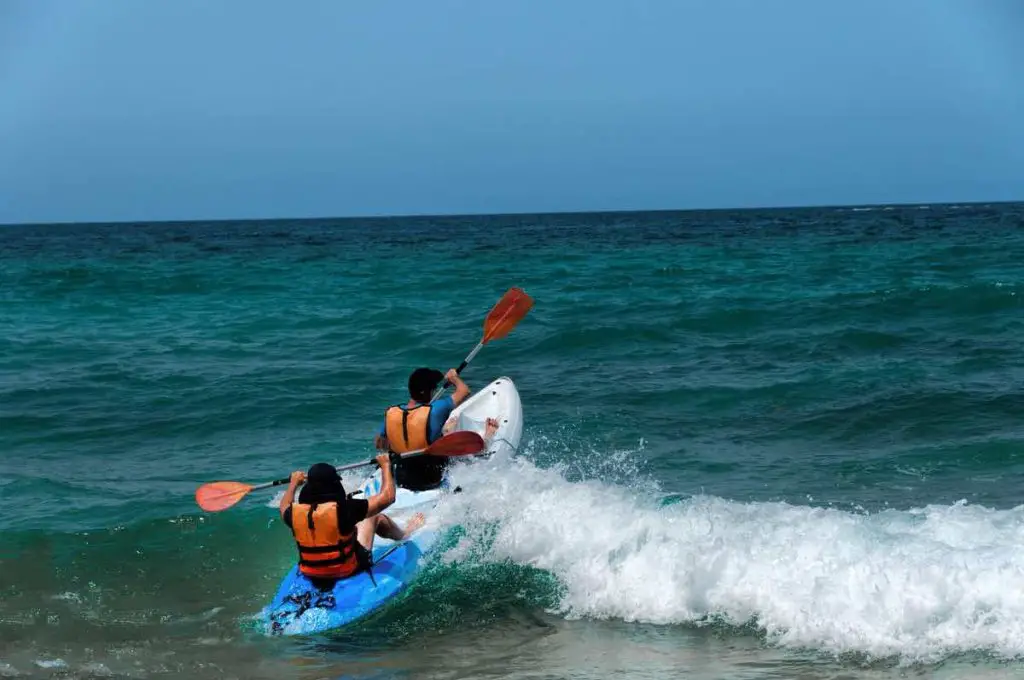When setting out on your kayaking adventure, it’s important to understand the conditions you and your watercraft can handle. Kayaks can be built to withstand turbulent waters, but that doesn’t mean they can handle all wave sizes. So what size waves can a kayak handle safely?
Kayaks can safely handle waves up to 3 feet (.91m). However, paddling in waves of this size requires proper training and a specific type of kayak: a sea kayak. Sea kayaks have a pointed bow and stern that cuts through waves and a rudder system for steering, making them ideal for rough waters.
In this article, I will teach you how to paddle your kayak in waves and discuss the paddle and rescue techniques you need to stay safe when you’re up against large waves. I’ll also cover some general-but-often-ignored kayaking tips to help you stay safe in rough waters. Keep reading for that and much more.

How To Paddle Your Kayak in Waves
To kayak safely in waves, you need to be well-trained in the different maneuver techniques so that you can be ready for whatever obstacles you face in open water.
What starts as a calm day on the water can quickly turn turbulent, and you must know how to navigate these waves so that you safely make it back to shore.
What To Do Before Setting Out
Before heading out on the water, there are a few things you should always check to confirm it’s safe to kayak. The last thing you want to do is be out in the ocean, and a storm forms above you, putting you in a dangerous situation.
- Always check the weather forecast for where you are planning to kayak
- Check the water temperature
- Be aware of wind conditions
- Access the water and know what type of waves are formed
If you’ve checked on all these things and have determined that it’s a great day for kayaking, then it’s time to get out on the water.
Face the Waves Directly
Once you are in the water, it’s best to position yourself facing the waves head-on. Having the kayak bow-to-stern in this direction helps with stability and maintaining your balance.
Facing the waves also allows you to keep an eye on them at all times so they can’t sneak up on you from behind. If the waves come up on you from behind unexpectedly, it can cause the bow of your kayak to submerge in water and the back end of your kayak to be vertical. This can end with your kayak being flipped and you going for an unplanned swim.
You also don’t want to position yourself parallel to the waves in a side position. You won’t have stability in this position, and that makes it easier for the waves to roll your kayak.
Power Into the Face of the Wave
Once you are positioned facing the waves, you will want to gain momentum. As the wave approaches and begins to crest, plant your blade on the back face of the wave and then power through. This is helpful because the force of the wave is trying to push you backward, but by having the blade of your paddle already planted on the other side of the wave, it’s pulling you through the wave.
When your blade is in the water, you have control of your movements. If your blade is in the air, you don’t have control; the wave does.
Do not hold the shaft of your paddle directly in front of your face. The waves crashing into you have a lot of force and can cause a facial injury. Keep your paddle slightly angled away from your face so you don’t encounter this problem.
Paddle and Rescue Techniques You’ll Need To Know
When kayaking in waves, the question is not if you’ll get rolled but when you’ll get rolled. You need to know these useful techniques to handle these less-than-ideal situations when they arise. Knowing what to do will lessen the chances of being overturned and allow you to correct your position if you do.
Practice these moves to become proficient and stay safe out on the waves.
- Low brace – This action is done with your paddle when you become slightly unstable in the water and must correct your balance quickly.
- Stern brace – This action uses the paddle and acts as a brake and steering.
- Flatwater roll, Steyr roll, and Layback roll – These are different rolling techniques you do when you find yourself upside down in the water while in your kayak, and you need to bring yourself back to an upright position. You must master these techniques to ensure your safety when kayaking.
- Pearl dive – This is when you come down the face of a wave, and your bow is directly straight with the current, causing water to come up on the bow of the kayak and push you vertically. To correct this, you should be on edge and sideways to the current. This allows the water to slide right off.
Tips To Stay Safe When Kayaking in Rough Water
Here are some things to keep in mind when preparing for your next excursion out on the water.
- It’s best to know how to swim; you never know when you’ll need to
- Be capable of getting in and out of your kayak in deep water
- Master all basic strokes and rescue techniques before attempting to kayak in waves
- Always wear a life jacket and a helmet
- Take plenty of water and snacks
- If the waves are higher than 3 ft (0.91 m), delay your trip
- Never consume alcohol while kayaking or leading up to your trip
What about locks? Are they safe for kayaks to go through? You can safely go through locks if you know how locks work. Click on the link to learn more about how to do it.

Final Thoughts
Kayaking through waves can be as exhilarating as it is intense. It requires you to clear your mind and let your instincts take control. This is why mastering paddle and self-rescue techniques are vital.
Kayaking through waves takes skill and experience. Always be cautious when setting out in open water. Most importantly, stay safe and enjoy the adventure.
